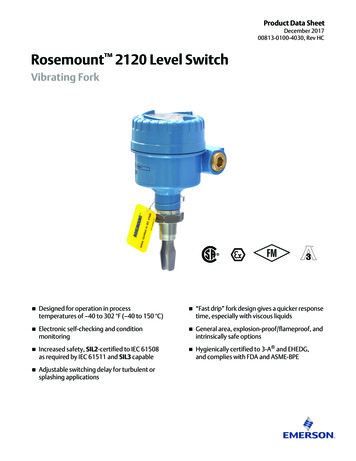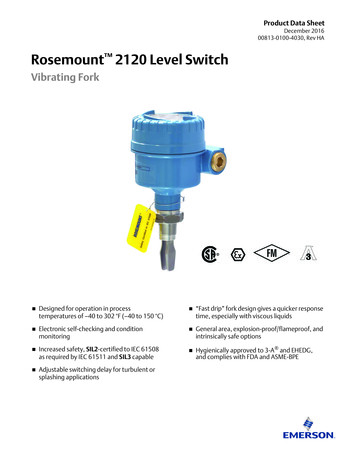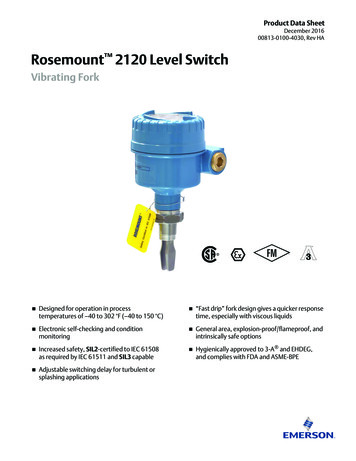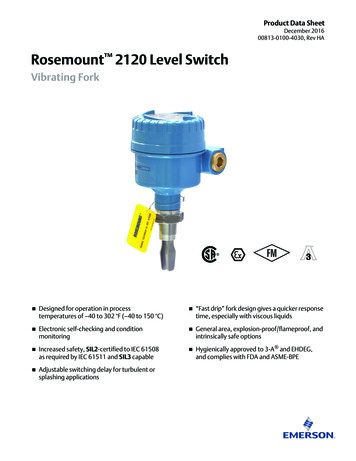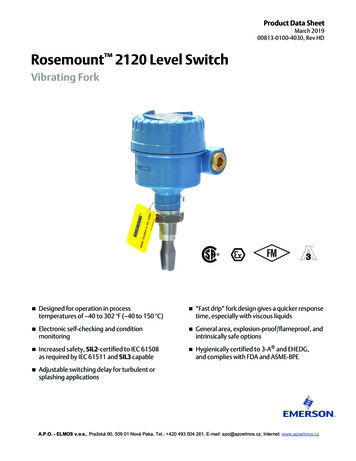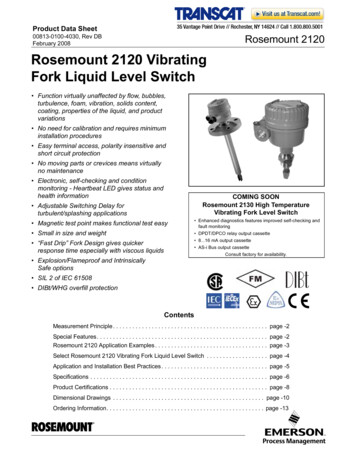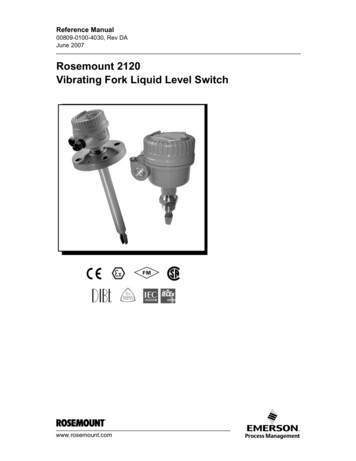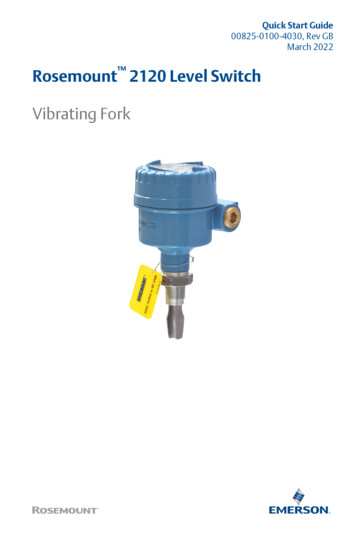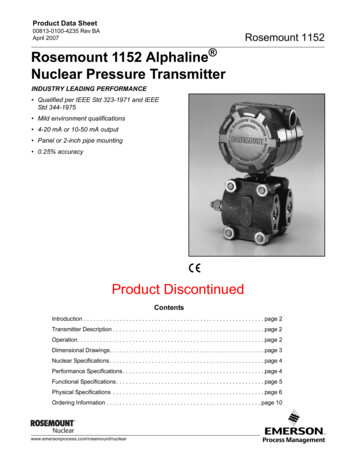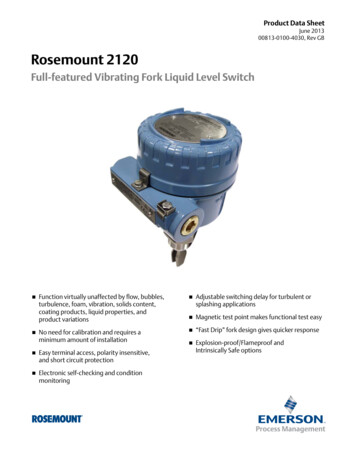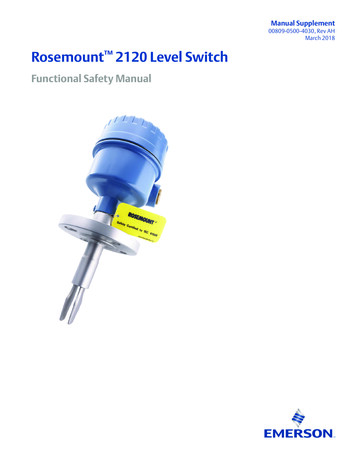
Transcription
Manual Supplement00809-0500-4030, Rev AHMarch 2018Rosemount 2120 Level SwitchFunctional Safety Manual
Manual SupplementContents00809-0500-4030, Rev AHMarch 2018Contents1Section 1: Introduction1.1 Scope and purpose of the safety manual . . . . . . . . . . . . . . . . . . . . . . . . . . . . . . . . . . . . . . . . . . . . . 11.2 Terms and definitions . . . . . . . . . . . . . . . . . . . . . . . . . . . . . . . . . . . . . . . . . . . . . . . . . . . . . . . . . . . . . . 11.3 Skill level requirement . . . . . . . . . . . . . . . . . . . . . . . . . . . . . . . . . . . . . . . . . . . . . . . . . . . . . . . . . . . . . 31.4 Documentation and standards . . . . . . . . . . . . . . . . . . . . . . . . . . . . . . . . . . . . . . . . . . . . . . . . . . . . . . 32Section 2: Product Description2.1 Operation principle . . . . . . . . . . . . . . . . . . . . . . . . . . . . . . . . . . . . . . . . . . . . . . . . . . . . . . . . . . . . . . . . 52.2 Level switch purpose . . . . . . . . . . . . . . . . . . . . . . . . . . . . . . . . . . . . . . . . . . . . . . . . . . . . . . . . . . . . . . . 52.3 Ordering information . . . . . . . . . . . . . . . . . . . . . . . . . . . . . . . . . . . . . . . . . . . . . . . . . . . . . . . . . . . . . . 63Section 3: Designing a Safety Function Using the Rosemount 21203.1 Safety function . . . . . . . . . . . . . . . . . . . . . . . . . . . . . . . . . . . . . . . . . . . . . . . . . . . . . . . . . . . . . . . . . . . . 73.2 Environmental limits . . . . . . . . . . . . . . . . . . . . . . . . . . . . . . . . . . . . . . . . . . . . . . . . . . . . . . . . . . . . . . . 73.3 Application limits . . . . . . . . . . . . . . . . . . . . . . . . . . . . . . . . . . . . . . . . . . . . . . . . . . . . . . . . . . . . . . . . . . 73.4 SIL capability . . . . . . . . . . . . . . . . . . . . . . . . . . . . . . . . . . . . . . . . . . . . . . . . . . . . . . . . . . . . . . . . . . . . . . 83.4.1 Systematic capability. . . . . . . . . . . . . . . . . . . . . . . . . . . . . . . . . . . . . . . . . . . . . . . . . . . . . . . . . 83.4.2 Random capability . . . . . . . . . . . . . . . . . . . . . . . . . . . . . . . . . . . . . . . . . . . . . . . . . . . . . . . . . . . 83.4.3 Failure rates in FIT. . . . . . . . . . . . . . . . . . . . . . . . . . . . . . . . . . . . . . . . . . . . . . . . . . . . . . . . . . . . 83.5 Safety certified identification . . . . . . . . . . . . . . . . . . . . . . . . . . . . . . . . . . . . . . . . . . . . . . . . . . . . . . . 93.6 Design verification. . . . . . . . . . . . . . . . . . . . . . . . . . . . . . . . . . . . . . . . . . . . . . . . . . . . . . . . . . . . . . . . . 93.7 Proof-testing. . . . . . . . . . . . . . . . . . . . . . . . . . . . . . . . . . . . . . . . . . . . . . . . . . . . . . . . . . . . . . . . . . . . . 103.7.1 Overview . . . . . . . . . . . . . . . . . . . . . . . . . . . . . . . . . . . . . . . . . . . . . . . . . . . . . . . . . . . . . . . . . . 103.7.2 Comprehensive proof-test . . . . . . . . . . . . . . . . . . . . . . . . . . . . . . . . . . . . . . . . . . . . . . . . . . . 103.7.3 Partial proof-test. . . . . . . . . . . . . . . . . . . . . . . . . . . . . . . . . . . . . . . . . . . . . . . . . . . . . . . . . . . . 113.7.4 Proof-test interval. . . . . . . . . . . . . . . . . . . . . . . . . . . . . . . . . . . . . . . . . . . . . . . . . . . . . . . . . . . 113.7.5 Tools required . . . . . . . . . . . . . . . . . . . . . . . . . . . . . . . . . . . . . . . . . . . . . . . . . . . . . . . . . . . . . . 113.7.6 Data required . . . . . . . . . . . . . . . . . . . . . . . . . . . . . . . . . . . . . . . . . . . . . . . . . . . . . . . . . . . . . . 113.8 Connection of the level switch to the SIS logic solver . . . . . . . . . . . . . . . . . . . . . . . . . . . . . . . . . . 123.9 General requirements . . . . . . . . . . . . . . . . . . . . . . . . . . . . . . . . . . . . . . . . . . . . . . . . . . . . . . . . . . . . . 124Section 4: Installation and Commissioning4.1 Safety messages. . . . . . . . . . . . . . . . . . . . . . . . . . . . . . . . . . . . . . . . . . . . . . . . . . . . . . . . . . . . . . . . . . 134.2 Installation . . . . . . . . . . . . . . . . . . . . . . . . . . . . . . . . . . . . . . . . . . . . . . . . . . . . . . . . . . . . . . . . . . . . . . 13Contentsi
ContentsManual SupplementMarch 201800809-0500-4030, Rev AH4.3 Physical location and placement. . . . . . . . . . . . . . . . . . . . . . . . . . . . . . . . . . . . . . . . . . . . . . . . . . . . 144.4 Electrical connections . . . . . . . . . . . . . . . . . . . . . . . . . . . . . . . . . . . . . . . . . . . . . . . . . . . . . . . . . . . . . 144.5 Configuration . . . . . . . . . . . . . . . . . . . . . . . . . . . . . . . . . . . . . . . . . . . . . . . . . . . . . . . . . . . . . . . . . . . . 154.5.1 Output mode setting. . . . . . . . . . . . . . . . . . . . . . . . . . . . . . . . . . . . . . . . . . . . . . . . . . . . . . . . 155Section 5: Operation and Maintenance5.1 Proof-test requirement. . . . . . . . . . . . . . . . . . . . . . . . . . . . . . . . . . . . . . . . . . . . . . . . . . . . . . . . . . . . 175.2 Repair and replacement . . . . . . . . . . . . . . . . . . . . . . . . . . . . . . . . . . . . . . . . . . . . . . . . . . . . . . . . . . . 175.3 Notification of failures. . . . . . . . . . . . . . . . . . . . . . . . . . . . . . . . . . . . . . . . . . . . . . . . . . . . . . . . . . . . . 17AAppendix A: SpecificationsA.1 General . . . . . . . . . . . . . . . . . . . . . . . . . . . . . . . . . . . . . . . . . . . . . . . . . . . . . . . . . . . . . . . . . . . . . . . . . 19A.2 Useful life. . . . . . . . . . . . . . . . . . . . . . . . . . . . . . . . . . . . . . . . . . . . . . . . . . . . . . . . . . . . . . . . . . . . . . . . 19A.3 Useful lifetime . . . . . . . . . . . . . . . . . . . . . . . . . . . . . . . . . . . . . . . . . . . . . . . . . . . . . . . . . . . . . . . . . . . 20BAppendix B: Proposed Comprehensive Proof-test ProcedureB.1 Suggested proof-test . . . . . . . . . . . . . . . . . . . . . . . . . . . . . . . . . . . . . . . . . . . . . . . . . . . . . . . . . . . . . 21B.2 Impact on SIF and process . . . . . . . . . . . . . . . . . . . . . . . . . . . . . . . . . . . . . . . . . . . . . . . . . . . . . . . . . 21B.3 Duration of comprehensive proof-test . . . . . . . . . . . . . . . . . . . . . . . . . . . . . . . . . . . . . . . . . . . . . . 22B.4 Personal safety concerns . . . . . . . . . . . . . . . . . . . . . . . . . . . . . . . . . . . . . . . . . . . . . . . . . . . . . . . . . . 22CAppendix C: Proposed Partial Proof-test ProcedureC.1 Suggested proof-test . . . . . . . . . . . . . . . . . . . . . . . . . . . . . . . . . . . . . . . . . . . . . . . . . . . . . . . . . . . . . 23C.2 Impact on SIF and process . . . . . . . . . . . . . . . . . . . . . . . . . . . . . . . . . . . . . . . . . . . . . . . . . . . . . . . . . 23C.3 Duration of partial proof-test . . . . . . . . . . . . . . . . . . . . . . . . . . . . . . . . . . . . . . . . . . . . . . . . . . . . . . 23C.4 Personal safety concerns . . . . . . . . . . . . . . . . . . . . . . . . . . . . . . . . . . . . . . . . . . . . . . . . . . . . . . . . . . 23DAppendix D: PFDavg CalculationD.1 Average probability of failure on demand (PFDavg) - 8 and 16 mA . . . . . . . . . . . . . . . . . . . . . . 25D.2 Average probability of failure on demand (PFDavg) - NAMUR . . . . . . . . . . . . . . . . . . . . . . . . . . 28D.3 Average probability of failure on demand (PFDavg) - PNP/PLC . . . . . . . . . . . . . . . . . . . . . . . . . . 30D.4 Average probability of failure on demand (PFDavg) - Relay. . . . . . . . . . . . . . . . . . . . . . . . . . . . . 32EAppendix E: PFH CalculationE.1 Probability of dangerous failure per hour (PFH) . . . . . . . . . . . . . . . . . . . . . . . . . . . . . . . . . . . . . . . 35FAppendix F: Diagnostic IntervalsF.1 Diagnostic checks and intervals . . . . . . . . . . . . . . . . . . . . . . . . . . . . . . . . . . . . . . . . . . . . . . . . . . . . 37iiContents
IntroductionManual SupplementMarch 201800809-0500-4030, Rev AHSection 11.1IntroductionScope and purpose of the safety manualThis safety manual contains the information to design, install, verify and maintain a Safety InstrumentedFunction (SIF) utilizing the Rosemount 2120 Level Switch (“level switch”).The manual provides the necessary requirements to enable the integration of the level switch whenshowing compliance with the IEC 61508 or IEC 61511 functional safety standards. It indicates allassumptions that have been made on the usage of the level switch. If these assumptions cannot be metby the application, the SIL capability of the level switch may be adversely affected.NoteFor product support, use the contact details on the back page.1.2Terms and definitionsRecycling of equipment and packaging should be taken into consideration and disposed of in accordancewith local and national legislation/regulations.Table 1-1. Terms and DefinitionsIntroductionTermDefinitionλDDDangerous DetectedλDUDangerous DetectedλSDSafe DetectedλSUSafe UndetectedBPCSBasic Process Control SystemCPTComprehensive Proof TestDiagnostic Coverage[DC] Percentage of detectable faults to undetectable faultsDiagnostic Test IntervalTime during which all internal diagnostics are carried out at least once.Fail dangerousFailure that does not respond to an input from the process (i.e. notswitching to the fail-safe state).Fail Dangerous DetectedFailure that is dangerous but is detected.Fail DangerousUndetectedFailure that is dangerous and that is not detected.Fail No EffectFailure of a component that is part of the safety function but that has noeffect on the safety function.Fail SafeFailure that causes the switch to go to the defined fail-safe state withoutan input from the process.Fail-safe stateState where the switch output is in the state corresponding to an alarmcondition. In this condition, the switch contacts will normally be open.1
Manual SupplementIntroduction00809-0500-4030, Rev AHMarch 2018Table 1-1. Terms and Definitions2FITFailure In Time per billion hoursFMEDAFailure Modes, Effects and Diagnostic AnalysisFunctional SafetyPart of the overall safety relating to the process and the BPCS whichdepends on the correct functioning of the SIS and other protection layers.HFTHardware Fault Tolerance as defined by 61508-2 7.4.4.1.1High demand modeThe safety function is only performed on demand, in order to transfer theEUC (Equipment Under Control) into a specified safe state, and where thefrequency of demands is greater than one per year (IEC 61508-4).Low demand modeThe safety function is only performed on demand, in order to transfer theEUC into a specified safe state, and where the frequency of demands is nogreater than one per year (IEC 61508-4).Level switch responsetimeThe time from a step change in the process until a level switch outputreaches 90% of its final steady state value (step response time as per IEC61298-2).PFDAVGAverage Probability of Failure on DemandPFHProbability of dangerous failure per hour.PPTPartial Proof TestRandom IntegrityThe SIL limit imposed by the architectural constraints that must be met foreach element.Safety Demand IntervalThe expected time between safety demands.SFFSafe Failure FractionSIFSafety Instrumented FunctionSILSafety Integrity Level - a discrete level (one out of four) for specifying thesafety integrity requirements of the safety instrumented functions to beallocated to the safety instrumented systems. SIL 4 has the highest levelof safety integrity, and SIL 1 has the lowest level.SISSafety Instrumented System (SIS) - an instrumented system used toimplement one or more safety instrumented functions. An SIS iscomposed of any combination of sensors, logic solvers, and finalelements.Systematic CapabilityA measure (expressed on a scale of SC 1 to SC 4) of the confidence that thesystematic safety integrity of an element meets the requirements of thespecified SIL, in respect of the specified element safety function, when theelement is applied in accordance with the instructions specified in thecompliant item safety manual for the element as per 61508-4.Type B deviceComplex device using controllers or programmable logic, as defined bythe standard IEC 61508.Introduction
Manual SupplementIntroduction00809-0500-4030, Rev AH1.3March 2018Skill level requirementSystem design, installation and commissioning, and repair and maintenance shall be carried out bysuitably qualified personnel.1.4Documentation and standardsThis section lists the documentation and standards referred to by this safety manual.Table 1-2. Associated DocumentationDocumentsPurpose of documents00813-0100-4030Rosemount 2120 Product Data Sheet00809-0100-4030Rosemount 2120 Reference ManualIEC 61508: 2010Functional Safety of Electrical/Electronic/Programmable ElectronicSafety-Related SystemsMOB 08-08-57 R004FMEDA Report Version V2, Revision R1 and later, for the Rosemount 2120Level SwitchTable 1-3. Associated StandardsIntroductionStandardsPurpose of standardsHRD 5:1994Handbook of Reliability Data for Components used in TelecommunicationsystemsIEC 60664-1Insulation coordination for equipment with low voltage systemsIEC 61511(ANSI/ISA 84.00.01-2004)Functional safety - Safety instrumented systems for the process industrysectorIEC 61984Connectors - Safety requirements and test3
IntroductionMarch 20184Manual Supplement00809-0500-4030, Rev AHIntroduction
Product DescriptionManual SupplementMarch 201800809-0500-4030, Rev AHSection 22.1Product DescriptionOperation principleThe Rosemount 2120 Level Switch (“level switch”) consists of a tuned fork with a driver and receiverelement, and integral interface electronics. The level switch is based on the principle that the resonantfrequency of a tuned fork changes when it is immersed in a liquid. The frequency change is detected andused to switch an electrical output.A range of output options are available to suit different applications.NoteFor all product information and documentation downloads, visit Emerson.com/Rosemount.2.2Level switch purposeThe level switch indicates, by means of an electronic output, whether the level of a process liquid isabove, or below, a certain point (the switching point).Figure 2-1. Example ApplicationOverfill protectionProduct Description5
Product Description00809-0500-4030, Rev AHMarch 20182.3Manual SupplementOrdering informationTypical Model Number: 2120 D 0A K 1 I1 A 0000 QTThe third option code after “2120” indicates the output type: E 12 Vdc (nominal) Relay F 12 Vdc (nominal) PNP/PLC G PNP/PLC Low Voltage (20 to 60 Vdc, 3-wire) H 8 and 16 mA K NAMUR T Direct Load Switching (Mains 2-wire) V RelayOutput types G, H, K and V have achieved a SIL rating. Each of these output types have different SafetyInstrumented System (SIS) parameters (see Table 3-1 on page 9).The other option codes in the model number refer to materials, fittings, and other mechanical optionswhich do not affect SIS parameters.Versions of the Rosemount 2120 with the QS option code are supplied with a manufacturer's prior-usecertificate of FMEDA data.Versions of the Rosemount 2120 with the QT option, if available, are supplied with a third-partycertificate of SIL capability.6Product Description
Designing a Safety Function Using the Rosemount 2120Manual SupplementMarch 201800809-0500-4030, Rev AHSection 33.1Designing a Safety Function Usingthe Rosemount 2120Safety functionFor safety instrumented systems usage, the electrical output is used as the primary safety variable. TheRosemount 2120 Level Switch (“level switch”) may be used in high level safety related applications only.It is important that the level switch is user-configured for the correct application.The measurement signal used by the logic solver must be the discrete levels set at the instrument outputused to indicate the sensor condition. A change in liquid level through the switch point of the level switchresults in the user configured state being set at the output by the instrument.3.2Environmental limitsThe designer of the SIF (Safety Instrumented Function) must check that the level switch is rated for usewithin the expected environmental limits. See the Rosemount 2120 Level Switch Product Data Sheet forenvironmental limits.NoteFor all product information and documentation downloads, see the on-line Rosemount 2120 web pageat Emerson.com/Rosemount.3.3Application limitsFailure to comply with the following requirements will result in the invalidation of the productssafety certification. Check for risk of media build-up on the forks. Avoid situations where drying and coating productsmay create excessive build-up (see Table 3-1 on page 8) or implement preventative maintenanceprograms to ensure the media buildup is insufficient to impair performance. Ensure there is no risk of 'bridging' the forks. Examples of products that create 'bridging' of forks aredense paper slurries and bitumen.It is very important that the SIF designer checks for material compatibility by considering process liquidsand on-site chemical contaminants. If the level switch is used outside the application limits or withincompatible materials, the reliability data and predicted SIL capability becomes invalid.The construction materials of a level switch are specified in the product data sheet and the productreference manual. Use the model code on the product label, and the ordering information table andspecification in these product documents, to find out the construction materials.Designing a Safety Function Using the Rosemount 21207
Manual SupplementDesigning a Safety Function Using the Rosemount 212000809-0500-4030, Rev AHMarch 2018Figure 3-1. Product Build-upOK3.4SIL capabilityThe following sub-sections describe the third-party assessed SIS parameters of the Rosemount 2120Level Switch (“level switch”). A safety Instrumented Function (SIF) designed with this product must notbe used at a SIL higher than stated.3.4.1Systematic capabilityThe level switch has met the manufacturer design process requirements of Safety Integrity Level (SIL) 3.These are intended to achieve sufficient Integrity against systematic errors of design by themanufacturer.3.4.2Random capabilityThe level switch is classified as a type B device according to IEC61508.Random Integrity for Type B device:3.4.3 Low and high demand: Type B element Output types G, H and K: SIL 2 @HFT 0, SIL 3 @HFT 1 Output type V: SIL 1 @HFT 0, SIL 2 @HFT 1Failure rates in FITTable 3-1 on page 8 summarizes the level switch failure rates. For detailed failure rate information,including PFDAVG and MTTR data, see the FMEDA report for the Rosemount 2120.8Designing a Safety Function Using the Rosemount 2120
Manual SupplementDesigning a Safety Function Using the Rosemount 212000809-0500-4030, Rev AHMarch 2018Table 3-1. Assessed ValuesOutput Type andModel Option CodeFailure rate (FIT)λSDλSUλDDλDUSFF(%)DC(%)8 and 16 NoteThe FMEDA report is available from the Rosemount 2120 Level Switch - Vibrating Fork web site page atEmerson.com/Rosemount. In the Documents section, there are SIL documents including the FMEDAreport and this safety manual.3.5Safety certified identificationAll Rosemount 2120 Level Switches must be identified as safety certified before installing into SISsystems. Verify that:1. The model code is suffixed with the QT option code.2. A yellow tag is affixed to the outside of the level switch.3.6Design verificationThe Failure Modes, Effects and Diagnostics Analysis (FMEDA) report for the Rosemount 2120 LevelSwitch details all failure rates and failure modes as well as expected lifetime.The achieved Safety Integrity Level (SIL) of an entire Safety Instrumented Function (SIF) design must beverified by the designer using a PFDAVG calculation considering the architecture, proof-test interval,proof-test effectiveness, any automatic diagnostics, average repair time, and the specific failures rates ofall equipment included in the SIF.Each subsystem must be checked to assure compliance with minimum Hardware Fault Tolerance (HFT)requirements. When using the level switch in a redundant configuration, a common cause factor of atleast five percent should be included in the safety integrity calculations.The failure rate data listed in the FMEDA report is only valid for the useful lifetime of the level switch. Thefailure rates increase after this useful lifetime period has expired. Reliability calculations based on thedata listed in the FMEDA report for mission times beyond the lifetime may yield results that are toooptimistic, i.e. the calculated SIL will not be achieved.Designing a Safety Function Using the Rosemount 21209
Manual SupplementDesigning a Safety Function Using the Rosemount 212000809-0500-4030, Rev AHMarch 20183.7Proof-testing3.7.1OverviewThe Rosemount 2120 Level Switch (“level switch”) must be tested at regular intervals to detect anyfailures not detected by automatic on-line diagnostics i.e. dangerous failures, diagnostic failures,parametric failures such that the unit can be repaired and returned to an equivalent as new state.It is the user's responsibility to choose the type of testing applied to the unit within their safety system.If an error is found in the safety functionality, the switch shall be put out of operation and the processshall be kept in a safe state by other measures until a repaired or replacement unit can be installed andcommissioned.The following proof-tests are suggested: Comprehensive (“bucket”) test Partial proof-testTable 3-2 can be used as guidance for selecting the appropriate proof-test.Table 3-2. Suggested Proof-testsOutput Type andModel OptionCode3.7.2Proof-testtypeProof-testcoverage(% of 8 and 16 mAHNAMURKPNP/PLCGRelayV75258 and 16 PartialTest rYesYesYesYesYesNoComprehensive proof-testThe comprehensive proof-test performs a complete test of the system elements. The sensor, measuringelectronics and output stage are all checked by virtue of changing of the sensor condition andobservation of the output.The suggested comprehensive proof-test sequence for the Rosemount 2120 is described in Appendix B:Proposed Comprehensive Proof-test Procedure.10Designing a Safety Function Using the Rosemount 2120
Manual SupplementDesigning a Safety Function Using the Rosemount 212000809-0500-4030, Rev AH3.7.3March 2018Partial proof-testThe level switch has the ability of performing a partial proof-test. This test has reduced diagnosticcoverage compared with the comprehensive proof-test, in that it is limited to exercising the output andmeasurement electronics only.The partial proof-test presents the following benefits: Provides a percentage of the comprehensive proof-test coverage, enabling the unit to be tested and itseffective PFD to be reduced by this percentage at the time of the test. See Appendix D: PFDavg Calculation for an example of benefits on system PFD calculations of partialproof-testing. Test can be performed “in-process” and takes less than one minute to complete. Provides capability to prolong comprehensive testing to align with standard plant maintenanceschedules. May give the user the flexibility to schedule the comprehensive proof-testing Interval to fit with a site'sscheduled plan.A suggested partial-proof-test scheme can be found In Appendix C: Proposed Partial Proof-testProcedure.3.7.4Proof-test intervalThe time intervals for proof-testing are defined by the SIL verification calculation (subject to the PFDavg).The proof-tests must be performed more frequently than or as frequently as specified in the SILverification calculation in order to maintain the required safety integrity of the overall SIF.Results from periodic proof-tests shall be recorded and periodically reviewed. For the specification ofcustomer requirements required to fulfill this SIS requirement, see 61511.NoteFor a valid result, always perform the proof-test on the product media and media conditions that will bestored in the vessel while the device is in operation.3.7.53.7.6Tools required Voltage or current meter, depending on output type Power supply Safety logic solverData requiredThe date, time and name of the operator that performed, or system that triggered, the proof-test, theresponse time and result of the proof-test will be documented for maintaining the proof-test history ofthe device for PFDavg calculations.Designing a Safety Function Using the Rosemount 212011
Designing a Safety Function Using the Rosemount 212000809-0500-4030, Rev AHMarch 20183.8Manual SupplementConnection of the level switch to the SIS logic solverThe Rosemount 2120 Level Switch should be connected to the safety-rated logic solver which is activelyperforming the safety function as well as automatic diagnostics (if any) designed to diagnose potentiallydangerous failures within the level switch. In some cases, it may also be connected directly to the finalelement.The Rosemount 2120 Level Switch Reference Manual gives full installation details for the level switch.NoteFor all product information and documentation downloads, see the on-line Rosemount 2120 web pageat Emerson.com/Rosemount.3.9General requirements The system and function response time shall be less than the process safety time. The level switch will change to its defined safe state in less than this time with relation to the specifichazard scenario. All SIS components, including the level switch must be operational before process start-up. The user shall verify that the level switch is suitable for use in safety applications by confirming the levelswitch nameplate and model number are properly marked. Personnel performing maintenance and testing on the level switch shall first be assessed as beingcompetent to do so. Results from periodic proof tests shall be recorded and periodically reviewed. The level switch shall not be operated beyond the useful lifetime as listed in the specification section ofthe product reference manual without undergoing overhaul or replacement.NoteFor all product information and documentation downloads, see the on-line Rosemount 2120 web pageat Emerson.com/Rosemount.12Designing a Safety Function Using the Rosemount 2120
Installation and CommissioningManual SupplementMarch 201800809-0500-4030, Rev AHSection 4Installation and CommissioningNoteFor all product information and documentation downloads, see the on-line Rosemount 2120 web pageat Emerson.com/Rosemount.4.1Safety messagesProcedures and instructions in this section may require special precautions to ensure the safety of thepersonnel performing the operations. Information that raises potential safety issues is indicated by awarning symbol (). Refer to the following safety messages before performing an operation precededby this symbol.Failure to follow these guidelines could result in death or serious injury.Make sure only qualified personnel perform the installation.Explosions could result in death or serious injury. Verify that the operating environment of the level switch is consistent with the appropriatehazardous locations certifications. Do not remove the level switch covers in explosive atmospheres when the circuit is alive. The level switch cover must be fully engaged to meet explosion-proof requirements.Electrical shock can result in death or serious injury. Avoid contact with the leads and terminals. High voltage that may be present on leads can causeelectrical shock. Make sure the main power to the level switch is off, and the lines to any other external power sourceare disconnected or not powered while wiring the level switch.NoteCustomer must follow the “Application limits” on page 7.4.2InstallationThe Rosemount 2120 Level Switch (“level switch”) must be installed as described in the installationsection of the product reference manual. Environmental conditions must not exceed the ratings in thespecification section.The level switch must be accessible for physical inspection.Installation and Commissioning13
Installation and Commissioning00809-0500-4030, Rev AHMarch 20184.3Manual SupplementPhysical location and placementThe level switch shall be accessible with sufficient room for cover removal and electrical connections,and allow for manual proof-testing to take place.The switch point is determined by the location of the level switch, and consideration must be given toallow the safe proof-testing of the level switch by forcing liquid to put the switch into its Fail-safe state.4.4Electrical connectionsWiring should be adequately rated and not be susceptible to mechanical damage. Electrical conduit iscommonly used to protect wiring. The wiring to this device must maintain creepage(1) and clearancedistances. Therefore, the conductors stripping length should be no greater than 6 mm and be free fromstray strands.1.14Creepage distance is a measurement that is commonly used in determining the conducting path of the flow of electricity.Installation and Commissioning
Manual SupplementInstallation and Commissioning00809-0500-4030, Rev AHMarch 20184.5Configuration4.5.1Output mode settingThe Rosemount 2120 Level Switch must be user-configured for an application so that the output is ON inthe Safe or Normal condition (see Table 4-1).The response time (seconds delay) may be set to a convenient value to prevent trips that are spurious i.e.not due to a real condition. Note that the Safety Response Time is the greater of 10 seconds and theselected seconds delay using the switch setting (see Table A-1 on page 19).Table 4-1. Output Mode SettingApplicationSwitch setting(Normal or Safe Condition)Dry OnHigh level alarmONDryr On ModeDryrWetDryrWetWet On ModeInstallati
The Rosemount 2120 Level Switch ("level switch") consists of a tuned fork with a driver and receiver element, and integral interface electronics. The level switch is based on the principle that the resonant frequency of a tuned fork changes when it is immersed in a liquid. The frequency change is detected and
